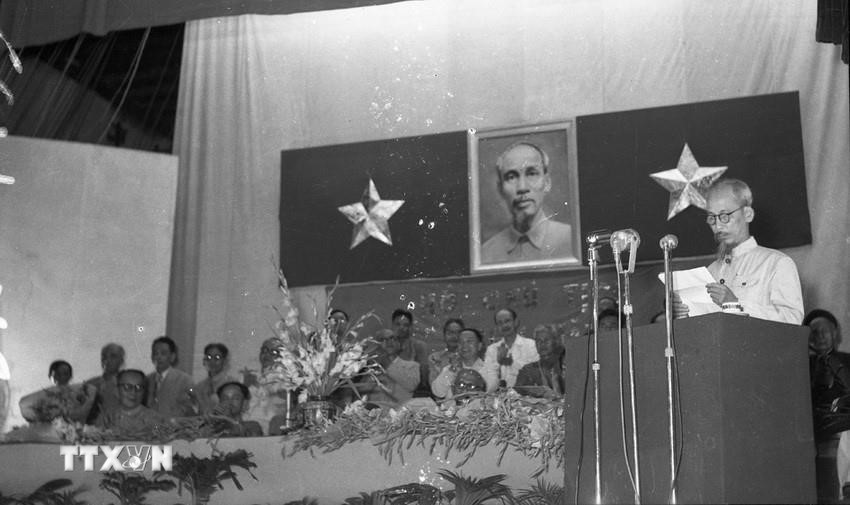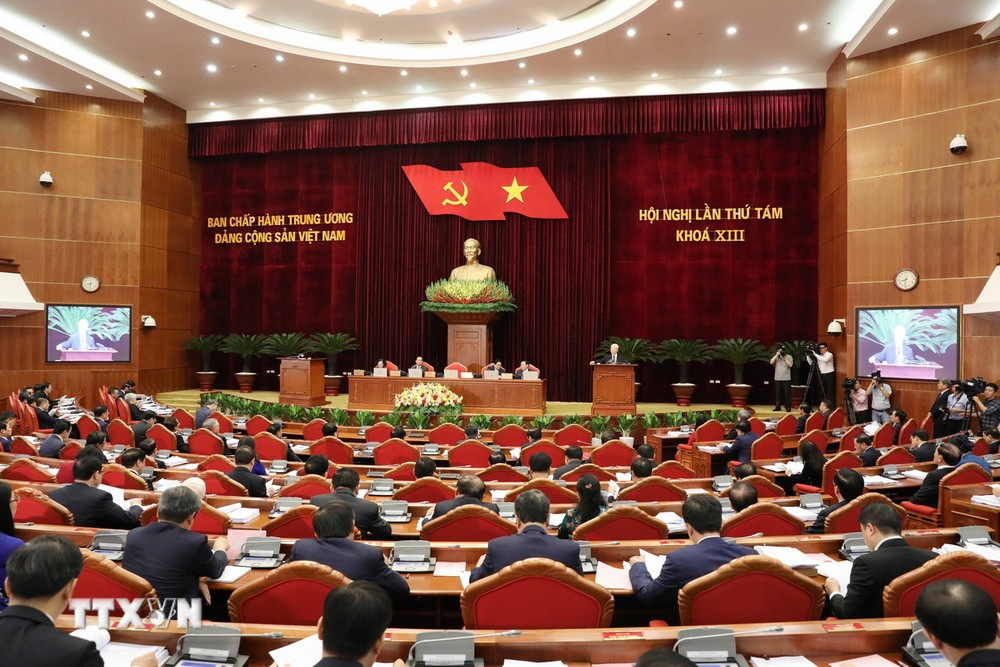President Ho Chi Minh and the Communist Party of Vietnam always creatively applied Marxism-Leninism to suit Vietnam's conditions, thereby leading the Vietnamese revolution from one victory to another.

Socialism is the goal and ideal of the Communist Party and the inevitable path of the Vietnamese revolution, in line with the development trend of the times.
Many experts and scientists believe that the creative application of Marxism-Leninism is one of the important factors and theoretical bases ensuring the success of the cause of building socialism in our country.
Associate Professor, Doctor Nguyen An Ninh (Ho Chi Minh National Academy of Politics) said that the Vietnamese revolution's choice of "the path of following Leninism" to liberate the nation and develop the country was the greatest theoretical achievement in President Ho Chi Minh's journey to find a way to save the country.
Of course, from the general theory of a doctrine of a worldwide nature, when applied to the practice of a country, a large amount of creativity of the Party and the leader is always needed.
Therefore, in current theoretical research practice, all countries developing in the socialist direction have an ideologist.
They were the first to recognize, propagate and successfully apply Marxism-Leninism to the country's revolutionary process. In Vietnam, President Ho Chi Minh is such a case.
According to Associate Professor, Dr. Nguyen An Ninh, Lenin considered the theory of "the world historical mission of the working class" to be "the focus and main content of Marxist doctrine."
He was also the great leader of the proletariat and the Russian Communist Party who carried out the success of the October Revolution in Russia (1917).
In short, the ideology of liberating the working class, liberating society, and liberating people is the main axis of this doctrine.
President Ho Chi Minh creatively applied the doctrine of class liberation as the theoretical basis for the process of national liberation.
Before that, all Vietnamese revolutionaries were on the "nationalist" stance. That is why at that time, Phan Boi Chau assessed that "socialism is the tank that stormed the citadel of nationalism."
National unity on the basis of "workers and peasants are the root of the revolution" and "other classes are friends" of the national liberation revolution and nation building is a very new and very creative idea of President Ho Chi Minh.
As practice has confirmed, this is a very correct idea because it is suitable for Vietnam's conditions.
A great innovation that needs to be mentioned is that President Ho Chi Minh was very concerned about the responsibility of contemporary Communist Parties for the issue of colonial national liberation.
It was Lenin who first mentioned this responsibility in an important document of the Second Congress of the Communist International (July 1920).
At this Congress, V.I. Lenin presented the “First Draft Theses on the National and Colonial Questions” and was supported by the entire Congress. From here, the revolutionary Nguyen Ai Quoc-Ho Chi Minh placed the process of national liberation in the process of proletarian revolution and considered “the Vietnamese revolution as a part of the world revolution.”
The Communist Party of Vietnam, founded and trained by him, “is the offspring of the nation,” is the Party of the working class and at the same time is “the Party of the Vietnamese nation.” Liberating the nation to create the premise for liberating the oppressed and exploited classes is a very new approach of President Ho Chi Minh.
“National independence associated with socialism” is also a typical example of Ho Chi Minh’s creative thinking. On the occasion of the first anniversary of Lenin’s death, Nguyen Ai Quoc wrote the article “Lenin and the Colonial Peoples,” in Red magazine (Soviet Union) No. 2 (1925).
Affirming Lenin's great contributions, he wrote: "In the history of the suffering and disenfranchised lives of colonial peoples, Lenin was the creator of a new life, a beacon showing the way to liberation for all oppressed humanity."
From that spirit, President Ho Chi Minh always linked national independence with the freedom and happiness of the people. When the country gains independence, the people must enjoy the values of socialism: “Everyone has food to eat, clothes to wear; everyone can study.”
Analyzing the proletarian revolution and national liberation revolution, Associate Professor, Dr. Le Thi Thanh Ha, Deputy Director of the Institute of Sociology and Development (Ho Chi Minh National Academy of Politics) said that C.Marx and Ph.Engels affirmed that the proletarian revolution would break out simultaneously in developed capitalist countries such as England, France, and America.
Lenin had already made a development when he believed that the proletarian revolution could break out in countries with average capitalist development like Russia and in colonial countries, the proletarian revolution could only succeed when the proletarian revolution in the mother country succeeded, then return to the proletarian revolution in the mother country.
President Ho Chi Minh and the Communist Party of Vietnam creatively applied Lenin's viewpoint when they said: "The national liberation revolution in the colonies does not necessarily depend on the proletarian revolution in the mother country, but can proactively win before the proletarian revolution in the mother country."
This is a very new and unique perspective of President Ho Chi Minh and the Communist Party of Vietnam. It was the creative application of this Marxist-Leninist theory to the Vietnamese revolution that led to Vietnam's victory in 1945.
Regarding class struggle, in the process of leaving to find a way to save the country, through practical surveys in countries on the continents of Europe, Africa, America and even in France, revolutionary Ho Chi Minh concluded that: Capitalism and colonialism are the source of all suffering of workers and peasants in both the "home country" as well as in the colonies; the French bourgeois revolution as well as the American bourgeois revolution are incomplete revolutions; "To save the country and liberate the nation, there is no other way than the path of proletarian revolution."
However, Ho Chi Minh did not “transport” the theory of Marxism-Leninism into Vietnam, because according to him, “Marx built his doctrine on a certain philosophy of history, but what history? European history. And what is Europe? It is not the whole of humanity.”
Therefore, Marxism-Leninism believes that the class problem determines the national problem: "If the exploitation of man by man is eliminated, the exploitation of one nation by another will also be eliminated."
But commenting on the specificity of the class struggle in the East, Ho Chi Minh wrote: "The class struggle does not take place like in the West, because the economic structure of Indochina, India or China is not like the medieval Western society, nor the modern one, and the class struggle there is not as fierce as here;" "Hearing people talk about class struggle, we also put out the slogan of class struggle, without considering the circumstances of our country to do it correctly."
From that, Ho Chi Minh believed that in Vietnam, class struggle must be closely linked to the struggle for national liberation from the standpoint of the proletariat class.
Regarding revolutionary forces, according to Marxism-Leninism, for the proletarian revolution to succeed, there needs to be an alliance of classes: workers, peasants and intellectuals.
But President Ho Chi Minh and the Communist Party of Vietnam affirmed that the national liberation revolution "is the common work of the entire people, not the work of one or two people;" "scholars, farmers, workers, and merchants are all united in opposing tyranny;" "workers and farmers are the masters of the revolution," "workers and farmers are the roots of the revolution;" "the national revolution has not yet been divided into classes, meaning that scholars, farmers, workers, and merchants are all united in opposing tyranny"...
In the current context, our Party affirms: "Great national unity is the strategic line of the Vietnamese revolution, a great driving force and resource in building and defending the Fatherland."
Great national unity on the basis of the alliance between the working class, the peasantry and the intelligentsia, under the leadership of the Party, is the strategic line of the Vietnamese revolution; it is the source of strength, the main driving force and the decisive factor ensuring the sustainable victory of the cause of national construction and defense.
“In the national liberation revolution and in the construction of socialism, President Ho Chi Minh and the Communist Party of Vietnam always creatively applied Marxism-Leninism and this has led the Vietnamese revolution from one victory to another,” Associate Professor, Dr. Le Thi Thanh Ha emphasized.
Associate Professor, Dr. Nguyen An Ninh said that the faithful and creative application of Marxism-Leninism is very important on the path of building socialism in Vietnam.
The first is the strategic orientation value for the Vietnamese revolution. Since choosing the “Leninist path,” the Vietnamese revolution has continuously achieved great victories and led the whole nation forward with the transitional era to socialism.
Marxism-Leninism asserts that socialism must be based on the material foundation of industrial revolutions and the development of the working class; promoting industrialization and modernization to build the material foundation of socialism in Vietnam, "building a modern, strong working class"... are very basic solutions suggested by Marxism-Leninism.

In particular, creatively applying Marxism-Leninism helps to constantly consolidate and develop the mastery position of the working class and the people brought about by the cause of building socialism.
That is the most fundamental and sustainable link that creates the strength of the whole nation in building socialism.
Associate Professor, Dr. Le Thi Thanh Ha said that on the path of building socialism in Vietnam, Marxism-Leninism is always the ideological foundation and the compass for all actions of the Vietnamese revolution.
Because Marxism-Leninism is a system of theoretical viewpoints and scientific methodologies that are crystallized and are the pinnacle of human intellectual achievements, of the cultural quintessence that humanity has created.
Marxism-Leninism is the only doctrine ever to set a goal and clearly show the path to completely liberate the working class, laboring people and oppressed peoples in the world from slavery and exploitation, from poverty and alienation in many aspects, bringing a life of prosperity, freedom and happiness to people.
TN (according to Vietnam+)